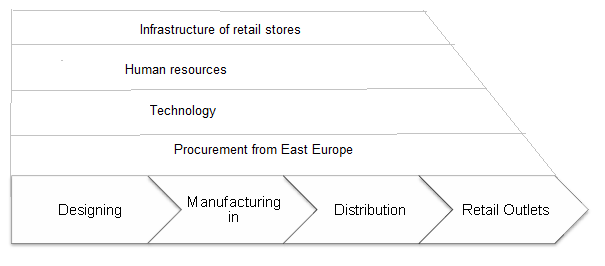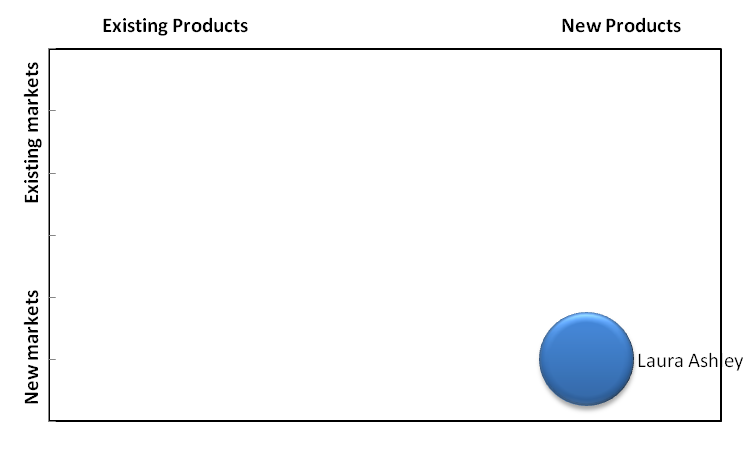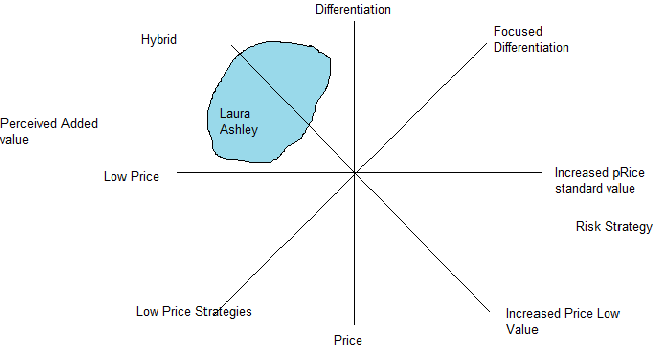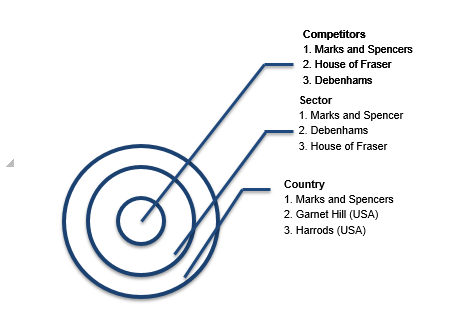Laura Ashley (LA) has its operations in designing, sourcing, manufacturing, distributing, and selling clothing and soft and hard lines for home furnishings. At the year-end of 2006, LA recorded a profit before tax of £6.1 million, an increase of 38.6 percent from 2005 (Laura Ashley, 2006). In this paper, the company’s strategic imperatives, sustainability, and background are critically evaluated, to determine if the strategy taken by the company is suited for long-term development.
Competitive strategy adopted by Laura Ashley
To understand the competitive strategy undertaken by the company in 2006, a thorough understanding of the internal environment of the company and the strategy that it undertakes. LA derives its competitive advantage through its shifting focus from fashion to home furnishing products, and through its sourcing activities.
Strengths and Weakness
First, an analysis of the strength and weaknesses of the company is done. The main strengths of the company as described by the company’s chairman in 2006 are their brand and their original lifestyle products that ensure to differentiate their products and creates customer loyalty. The other strength of the company in 2006 was its strengthening of the balance sheet throughout 2003-06 (Laura Ashley, 2006).
This is so because the financial performance was weak for 2003 through 2005 (Laura Ashley, 2003; Laura Ashley, 2004; Laura Ashley, 2005), and it was after 2005 that the company’s balance sheet started showing internal strength. There was an increase in profit from £4.7 million in 2005 to £5.4 million in 2006 (Laura Ashley, 2006). Further, the profit as a percentage of revenue has increased to 2.6 percent in 2006 (Laura Ashley, 2006).
Due to the turnaround of the companies, banks have not been unwilling to pay loans that have increased from £3 million in 2005 to £5.8 million in 2006. The company has its divisions diversified into four main furniture, home accessories, decorating, and fashion (Laura Ashley, 2006). Furniture had the largest share of business in the UK with 31 percent, then home accessories for 29 percent, decorating 23 percent, and fashion for 17 percent (Laura Ashley, 2006).
There was a major shift in the product strategy of the company from 2005 through 2006, when the company shifted its concentration from fashion to home swear, as there was a continuous fall in sales of fashion sales in the UK (Cabinet Maker, 2006). The reason for the strong financial success in 2006 has been due to the company’s strategy to reduce floor space for the fashion category and increase concentration on home furnishing (Cabinet Maker, 2006).
Weaknesses of the company are in its outdated fashion, which resulted in a fall in the demand for its fashion wear in 2005 (Barnes, 2005). The overall group sales were down in 2006 by 11.6 percent (Laura Ashley, 2006). The home-furnishing segment has faced a fall in sales by 1.4 percent and the furniture segment has posted a marginal rise in sales by 0.2 percent in 2006 (Laura Ashley, 2006). Therefore, two of the major business divisions of LA performed poorly during 2006.
Value Chain
The primary activities that are important for LA are shown in figure 1. The first main function that is important for LA’s business is designing. The designing of home furnishings or fashion brands is important for the company as it is essentially a fashion brand. Therefore, the employment of well-known designers who can change the products as well as retain the essence of the company must be done. The second activity identified is sourcing. For all retain companies sourcing the raw material at the cheapest possible price is essential as this will reduce the cost of operation. Manufacturing of the products is important, as this will enable the company to produce the goods to be sold.

Distribution of LA is done with the help of the global logistics company Federal express (Raggad, 2001 ). Therefore, logistics and distribution have been outsourced to a third party so that LA could concentrate more on its main products. There were 180 LA stores in the UK, out of which, 78 are mixed product stores, 58 Home stores, and 44 home concession stores (Laura Ashley, 2006). From this analysis, the primary activities of LA are described. The area where LA must enforce more attention is in sourcing which will enable it to gain cost competitiveness over competitors.
V. R. I.O.
V. R. I.O. is the acronym for value, rarity, imitability, and organization. LA’s product offerings are moderately valuable as they cater to the market segment of above 30s. The products are not rare as there are competitors like IKEA in home furnishing and Marks Spencer’s in fashion who compete with the brand. The products are easy to imitable like all other fashion brands, as their designs are not legally endorsed. Further, the business model of sourcing in a foreign location with cheaper costs is a possible imitable concept. The organization has shifted its product focus from fashion products to Home products. Further, the target segment has also been shifted from above-50s to above-30s, and the brand has made a sway from fashion exclusivity to more commercialized product offerings.
Is a competitive advantage sustainable?
The strategy of sourcing the products from a foreign location at a cheaper price is better for LA as this will allow the company to increase its core product offering and producing them at a cheaper price. This competitive advantage is a sustainable strategy, as this will allow the company to increase profit and generate more cash for the business.
Development strategy adopted by Laura Ashley
Ansoff matrix

The Ansoff matrix is used to determine the product strategy taken by the company. The matrix tried to determine the growth of a business through the current strategy of the company through its market segments and products (Proctor, 2000). The strategy taken by LA is of diversification as the company had changed its target customers from above 50 to above 30 (Cabinet Maker, 2006). Further, the product line has been revamped with less concentration on
Porters generic strategy
The generic strategy that La has adopted is the cost strategy. There are three generic strategies as suggested by Michael Porter – cost strategy, differentiation, and mixed strategy (Porter, 1985). To minimize cost, the company has shifted its sourcing base to East Europe and Asia for cheaper raw materials and low labor costs. However, the products are designed exclusively for LA and thus, have the tag of an exclusive lifestyle brand. Thus the strategy of the company is mixed i.e. both cost and differentiation.
Bomans clock
The Bowman’s Clock is a suitable method to analyze the competitive strategy of the company vis-a-vis its competitors (Thomson, 2010). The analysis of the Bowman’s Clock shows that LA has a hybrid strategy with its products becoming more commercialized and prices, therefore becoming lower than before.

Recommendations for future development
From the above analysis, it can be deduced that the main strategy of the company is mixed. As the company has diversified from its fashion products to home products, therefore there is a drive for differentiation. Further changing the target market has also made the company look at a new market segment.
From the above analysis, it can be deduced that.
Laura Ashley’s external environment
Onion ring

The onion rings demonstrate that the main competitor of the company is Marks and Spencer’s, Debenhams, and House of Fraser. In this sector, the previously mentioned brands are direct competitors of LA as they also offer fashion apparel, home furnishings, and furniture. In country-based competitors, La has its competitors in the USA like Marks and Spencer’s, Garnet Hill, and Harrods.
PESTLE analysis
Figure 4 PESTLE Analysis.
LA operates in the UK, USA, Spain, Japan, and Australia. The PESTLE analysis will be done to understand the political, economic, social, technological, legal, and environment. The analysis shows that the three countries USA, Japan, and Australia where the LA company operates apart from the UK, do not pose any threat to its operations.
Porters five forces
The five forces analysis is a method of understanding the competitive forces that operate in the industry (Porter, 1996). The threat of rivals is high in the USA and Australia, while low in Japan, as there are no other retailers in Japan who offer such a variety of products together, whereas, in the USA and Australia other retailers are giving similar offerings. Supplier forces for all three countries are low as the LA sources its products from East Europe and Asia.
Buyer forces are high in all the three countries, as the people have choices of competitive products as well as substitutes. Threats of substitutes are high as there are a lot of local manufacturers as well as specialized manufacturers producing similar fashion apparel or furnishings. Barriers to entry are high as the business requires high initial investment and extra cost to diversify.
Opportunity and Treat
Opportunities for the company lie in diversification o fit brands and expansion into new markets. The opening of many fast-developing markets poses a new opportunity to the company. For the USA, the opportunities are in increasing consumer demand and high spending of the consumers. Similar to Japan, the opportunity is in the economy’s high growth level. In Australia, consumer expenditure is high. Further, the opening
The threats that are posed in the USA are the slow growth rate of the economy and aging pupation. Aging pupation is a problem for LA even in Japan and Australia, as it has changed its target segment from over-50s to over-30s. The other threat that can be observed is the level of competition for LA in these countries, as direct competitors of the company operate in these countries.
References
Barnes, R., 2005. Laura Ashley. Web.
Cabinet Maker, 2006. Homewares shift lifts Laura Ashley. Web.
Cabinet Maker, 2006. Laura Ashley is back in profit. Cabinet Maker. p.6.
CIA, 2010. The World Factbook. Web.
Laura Ashley, 2003. Annual Report. Web.
Laura Ashley, 2004. Annual Report. Web.
Laura Ashley, 2005. Annual Report. Web.
Laura Ashley, 2006. Annual Report. Web.
Porter, M., 1985. Competetive Advantage. New York: Free Press.
Porter, M.E., 1996. What is Strategy? Harvard Business Review, pp.2-19.
Proctor, T., 2000. Strategic marketing: an introduction. London: Routledge.
Raggad, B., 2001. How Can A Firm Convert Its Global Presence to Global Competitive Advantage to Gain Certain Benefits? Web.
Thomson, N., 2010. Strategy in Context. West Sussex: Wiley and Sons.
